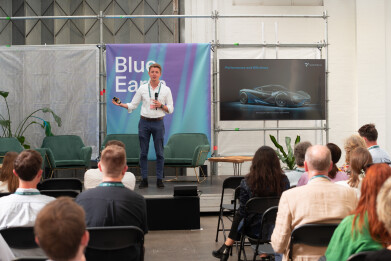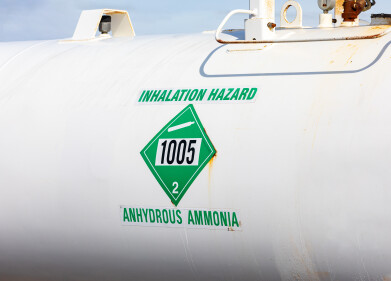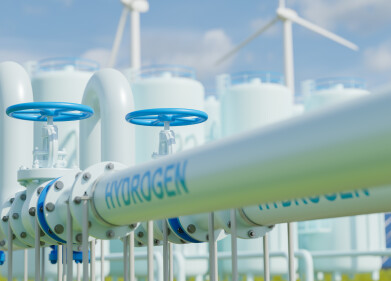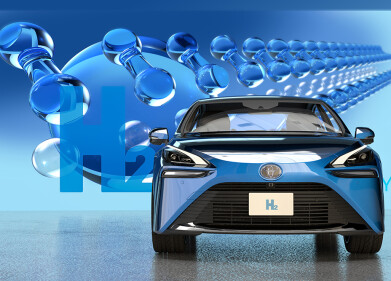Hydrogen fuel
The heavier the vehicle and the longer the range, the more useful hydrogen becomes: What a hydrogen start-up thinks about the future of trucking
Aug 27 2024
Last month, PetroOnline visited the Blue Earth Forum in London, which brought together investors and startups offering solutions in line with the United Nations’ sustainable development goals. Alongside each pitching session, thought leaders and industry veterans took part in panel discussions covering all topics in sustainability and climate tech, from air pollution and soil regeneration to renewable energy and bioplastics.
During the Forum, we got the chance to discuss what the future might hold for hydrogen with Joe Ritblat, CFO at Viritech, a hydrogen powertrain clean tech firm that was pitching to investors. Currently, among their many exciting projects, they’re working on a powertrain for a 40-tonne truck to be shown at the Cenex Expo in September.
Why is hydrogen the right renewable solution for heavier vehicles?
Investors often ask: is it batteries or hydrogen? That’s really the wrong question; both have an important role to play in delivering zero-emission mobility, with the choice depending upon the duty cycle of the vehicle. To help understand this, let’s define the alternatives: battery-electric vehicles (BEVs) rely entirely on power stored in a battery; hydrogen-powered vehicles store energy in the form of hydrogen gas or liquid, which is used to generate electricity with a fuel cell (FCEV) or to burn in an internal combustion engine (HICE).
If you’re dealing with lightweight vehicles in an urban environment where you have well-known distribution routes or your car journeys are local, BEVs are ideal. However, if you’re transporting heavy goods, your route is unpredictable, range is a consideration or the topology’s challenging, the size and weight of battery required becomes a growing problem; this increase in weight is called ‘mass compounding’. In any application where power-to-weight is critical, e.g. high-performance and commercial vehicles, aircraft and marine vessels, mass compounding erodes the effectiveness of batteries, and this is where hydrogen offers a better solution.
But to be clear, this is not entirely at the expense of batteries: in fact, battery technology is very important to us. Our hydrogen powertrains utilise very power-dense battery packs, which require different characteristics to batteries used in BEVs, so we’re certainly not ‘anti-battery’. We use batteries to recapture energy from regenerative braking, and using a combination of fuel-cell and battery allows us to optimize the size of each for maximum efficiency: fuel-cell power for steady cruising, and battery for ascents and acceleration.
For example, in the light commercial vehicle (LCV) sector, we’re currently working on the Fuel-cell Commercial Vehicle Generation 2.0 APC project, with Ford, BP and Ocado, centred on the Ford Transit Van. The Transit Van is the best-selling van in Europe and the US, so is a good leading indicator of market demand. Ford’s customer research has confirmed that even with the current high pace of advancement in battery technology, it is unlikely in coming years that BEV will fulfil those LCV use-cases that require high daily energy, range, payload or have limited opportunities for charging. FCEV is a zero-emissions alternative that can address this gap.
When we look to heavy goods vehicles (HGVs), where net operating margins are wafer-thin, with a 40-tonne truck requiring around 5 tonnes of battery to meet a typical duty cycle, the payload will be significantly reduced and margins therefore reduced even further. Hydrogen solves this issue, and as a company with its roots in motorsports, Viritech’s focus is to deliver lightweight, energy-efficient hydrogen powertrain solutions, capable of delivering weight and performance parity with internal combustion vehicles.
In terms of the breadth of application, our hydrogen powertrain solutions scale really well to meet a range of use cases. All of our technology was designed around the requirements of a hypercar, which required every component to be optimised in terms of weight, space, and performance (you can see the Apricale project here). This performance efficiency has been carried over into every solution we have designed, whether for automotive, aerospace, marine or distributed power.
Regarding infrastructure for hydrogen, how is the UK doing?
The common challenge of new fuels for transport is infrastructure roll-out. Over the last 15 years we have seen battery-electric charging points become increasingly ubiquitous – though questions remain about the grid’s capacity – but the infrastructure dynamics are very different for hydrogen.
For road transportation, we see early adoption coming in the commercial transport sector, with the expectation that for now this will be in selected niche applications to prove the use case, expanding in the latter part of the decade as hydrogen technologies mature, production volumes expand and costs come down. Instead of a very wide network of refueling stations across the UK, hydrogen demand from commercial transport fleets could be adequately served by a relatively slim motorway-based ‘spine’ refueling network, combined with depot refueling. Recognizing this, the European Union has now mandated a hydrogen refueling station every 200km on its major motorways by 2030.
As we move into the 2030s, we expect strong growth in the adoption of hydrogen mobility, extending to many classes of vehicle transport, with particular growth in oil-exposed jurisdictions seeking to diversify, such as the Middle East, as well as the larger continents, which lack the grid infrastructure to support the roll out of BEVs and which are naturally bestowed with solar and/or wind power to produce green hydrogen, such as India, Africa and South America.
Looking beyond road transport, we expect strong adoption of hydrogen in aerospace and marine, as well as distributed power, and we are already working on powertrain projects in all of these sectors, with defense also expected to become a big user of hydrogen.
What’s the difference in utility between hydrogen combustion engines and fuel cells?
In terms of the merits of FCEV (fuel-cell-electric vehicles) versus HICE (hydrogen internal combustion engine), we expect fuel cells, which ultimately will deliver greater energy efficiencies, to become the dominant technology within 20 years as the technology matures and costs come down.
However, we are big supporters of HICE - we are developing solutions using both technologies - because at this point in the development of hydrogen technology, HICE is the cheaper and more deliverable solution. It’s really encouraging to see many automotive OEMs now focusing on this opportunity for uses where longer range or higher load capacity are required.
So, in the first wave of hydrogen adoption, expect HICE to lead the way, and in doing so, to seed the hydrogen refueling infrastructure which will support the broader hydrogen mobility revolution.
Digital Edition
PIN 25.6 Buyers' Guide
January 2025
Buyers' Guide Directory - Product Listings by Category - Suppliers Listings (A-Z) Articles Analytical Instrumentation - ASTM D7042: The Quantum Leap in Viscosity Testing Technology -...
View all digital editions
Events
SPE Hydraulic Fracturing Technology Conference and Exhibition
Feb 04 2025 The Woodlands, TX, USA
Feb 05 2025 Guangzhou, China
Trinidad and Tobago Energy Conference 2025
Feb 10 2025 Point Lisas, Trinidad
Feb 11 2025 Lagos, Nigeria
Feb 13 2025 Manama, Bahrain



















